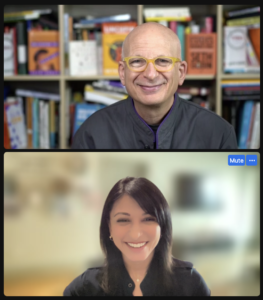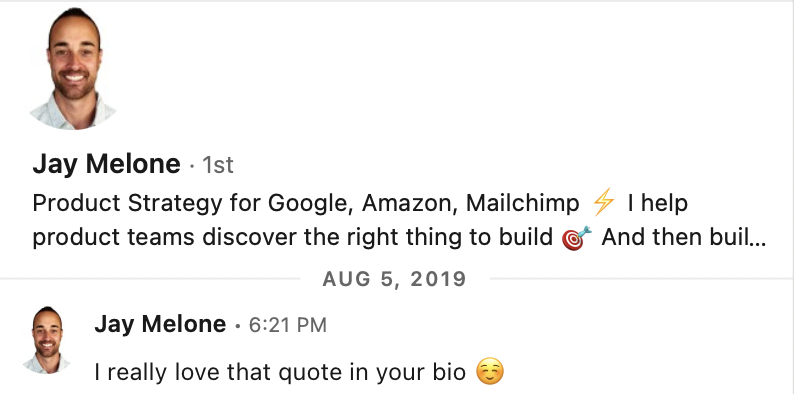The countdown to my 40th birthday is on! As I reflect on the last decade this quote from Bill Gates resonates:
“Most people overestimate what they can do in a year and underestimate what they can do in a decade.”
Bill Gates
Instead of the traditional “10 Lessons I’ve Learned,” post, I’m going to share five lessons from the one investment that filled the last decade with memorable opportunities, experiences, and people.
That investment was the creation of a professional online presence and network.
TL;DR
I’m hosting a free workshop next week on how to Build Leadership and Social Influence with LinkedIn. In this post, I’m sharing the five ways investing in my professional online presence and network changed the trajectory of my career.
The Best Professional Investment I Made in the Last Decade
Lesson 1: We Aim Too Low
The greatest danger for most of us lies not in setting our aim too high and falling short but in setting our aim too low and achieving our mark.
Michelangelo
Juliana Finegan recently invited me onto her podcast where she asked me if when I first graduated as a high school history teacher in 2007 I imagined being where I am now. The answer was an unequivocal no. In fact, many of the roles I’ve had over the past ten years were not even on my radar.
For example, I was the Director of Innovative Learning at the Keck USC PA Program. Never imagined as a history teacher there would be a role for me in a medical school. Or Education Leadership Executive at Apple. Never imagined when I started teaching that I’d find myself in tech companies like Apple, and later Wix.
Over the past few years, being able to browse people’s profiles, especially on LinkedIn gave me tremendous insight into other possibilities. Ones that were never mentioned during my undergrad and graduate school days. And ones that also I might add were not part of career days or fairs.
When I stepped foot into my classroom at Northwood High School, I thought I was going to be there for the next 10 years. With the onset of the recession and the budget cuts that followed, I stayed there for only 9 months. While it did not feel like it at the moment, it probably was the best thing that ever happened. The layoff shattered the expectations I and others were taught about the world of work:
Do well in school > graduate > get a job = stability.
I started the first year of this past decade reading Seth Godin’s Linchpin, I ended the decade interviewing him for my podcast and documentary. It forced me to lean into my strengths. It taught me I was capable of creating and contributing to more than I had thought possible. Seth Godin replied to my email within 24 hours of my message request. Why?

As he said during our conversation:
“Your online reputation precedes you.”
This brings me to lesson 2 – creating value-driven relationships.
Lesson 2: Creating Value-Driven Relationships
Seth Godin and I connected because we had a shared vision – eradicating the industrial model of education. When you click or Google my name, I want you to immediately know who I am and what I believe in. Have you Googled your name recently? Is it an accurate representation of who you are and what you represent?
Recognizing your strengths is one part. Sharing them is another. We’re no longer bound by the proximity of our zip code. In today’s hybrid and remote first world our first impression is often a digital impression. When we share our vision and values, we remind ourselves and others that we are not alone. We connect with people we didn’t even know existed and through our posts, videos, and writing connect in service of a shared vision for the beliefs and values we hope to see. Over the years my blog posts have brought me consulting opportunities, speaking engagements, podcast interviews, and invitations to events.
A highlight from this past decade was being invited to the Google Design Sprint Conference by Kai Hailey, former Head of Google Design Relations. I was introduced to Kai through Jay Melone, founder of New Haircut, a design sprint firm. We connected on LinkedIn when we were participating in a discussion on a post.

That’s the power of sharing just one line. In sharing my vision, we immediately connected based on shared vision and values. After a call where we learned how we were applying design thinking and design sprint practices in our different industries he immediately made an introduction to Kai. The Google Design Sprint Conference was transformational to my research, and practice of applying design thinking and design sprint practices in education.
This brings me to lesson 3 – the power of an interdisciplinary network.
Lesson 3: The Power of an Interdisciplinary Network
Prior to having a professional online presence, I was only meeting people in my field – education. While socially I knew people across different professions, when it came to conferences and deeper learning, being exposed to other industries was mostly through books. In having a diverse network of people from industries across marketing, business, medicine, AI, economics, and more, I’m able to gain daily insights into their challenges, opportunities, and insights.
A highlight from this past decade was another author who I went from hearing on YouTube to having as a mentor. When I first heard Erik Brynjolfsson, co-author of The Second Machine Age, former MIT professor, and current Director of Digital Economy Lab at Stanford speak at the World Economic Forum he said one line that changed how I approached the integration of technology in education. He said:
“Technology is not destiny. We shape our destiny.”
After hearing him speak in 2014 I began to wonder, “How might we shape our destiny? This led me to learn about design thinking, and it changed my approach and reputation. From being a follower of his on social media to having him as a mentor is a testament to one of the most powerful forces today – we no longer just read and cite authors, we can speak with them, interact with them, and collaborate with them.
The challenges we face in our education system cannot be solved in silos. Having an interdisciplinary network brings me to lesson 4 – exposure to existing and emerging trends.
Lesson 4: Exposure to Existing and Emerging Trends
If I asked you to share the top 5 existing and emerging trends and how they will impact your career over the next 5, 10, and 15 years what would you say? I often hear from educators how they don’t feel that they have exposure to what else is out there because they are in their classrooms and schools. With the internet, we are no longer bound by proximity. However, we need to actively teach people how to create a professional online presence, and how to build a network.
A highlight from the past decade was being connected to people in the design sprint industry, in particular Mural, who were at the forefront of leading dialogue and sharing examples of how to thrive in creating collaborative remote cultures during the pandemic. In 2020 I was an education leadership executive at Apple working with districts in California. As a result of this network, I was able to be at the forefront of leading our Apple Education team working with districts in creating remote cultures that were engaging, collaborative, and inclusive. I did a series of interviews with people from the industry, one of my favorites being with Ross Chapman, who at the time was Head of Design Thinking at Etch. At a time when people were struggling to transition, Ross was at the forefront of leading and answering, “How might we work better together.”
Having an interdisciplinary network is a daily reminder that we’re all great at something, but we can’t be great at everything. In today’s world of accelerated innovation and change, having a diverse network empowers you to be vulnerable. This brings me to what has perhaps been the most significant lesson – the power of saying, “I don’t know.”
Lesson 5: The Power of “I Don’t Know”
Having a professional online presence and network, gave me the confidence and courage to know where I do and do not excel. It’s taught me what energizes me, and with each post and interaction, my self-awareness deepens daily. This has made me vulnerable enough to be able to say, “I don’t know when people ask me questions.”
In an episode on Re: Thinking Adam Grant interviews Satya Nadella, CEO of Microsoft, and asks him how he developed his confidence to share his mistakes and vulnerabilities. Nadella talks about the importance of creating a culture of psychological safety where everyone can share what they don’t know. He shares an approach called:
“Model – Coach – Care”
While we all strive to create these environments within our own workplaces, it doesn’t always exist. When I reflect back on my own experiences, I can say I truly felt a culture of psychological safety in only one of my workplaces out of many. However, through surrounding myself with a diverse group of individuals where relationships thrived through collaboration based on strengths, values, and vision, I was able to create this for myself online.
I experienced just how powerful this can be when I first met and had the privilege of working with Devin Vodicka, CEO of the Learner-Centered Collaborative. I was first introduced to Devin when Joe Erpelding, former principal at Design39 where I filmed the documentary, brought a group together to host a virtual conference in 2020 called, “A New Way Forward.”
At the time I was also in the last semester of my doctoral program. Devin is an advocate and has done extensive research on the importance of building relational trust. We wrote articles together on the topic and had many conversations. However, we had yet to meet in person. At SxSWEdu in 2022, Devin asked me what my launch plan was for the documentary.
I quite honestly shared, “I don’t know yet.”
He then shared an idea and the rest is history. You can view highlights from the documentary premiere here and it is a testament to the power of saying, “I don’t know.”
It opens the door for an idea to put on the table, where it no longer belongs to just one person. Instead, it belongs to the collective, where everyone can merge their strengths and skills to accelerate the outcome.
2023, and I imagine the years that follow bring so much uncertainty. And in times of uncertainty, there are a few constants we can hold onto – our strengths, and our network. One reminds us of what we’re capable of, and when we pair this with people who are there to support us every step of the way, we develop the courage and confidence to confront ambiguity and we become as Sia would say – unstoppable.
On December 3rd I’m hosting a workshop for how to build a professional presence and network using LinkedIn. It’s the best place to invest your time in 2023, and I’ll help you create a unique profile and content plan.

I’m Sabba.
I believe that the future should be designed. Not left to chance.
Over the past decade, using design thinking practices I've helped schools and businesses create a culture of innovation where everyone is empowered to move from idea to impact, to address complex challenges and discover opportunities.
stay connected
designing schools